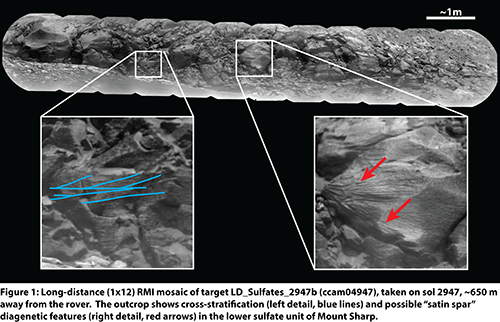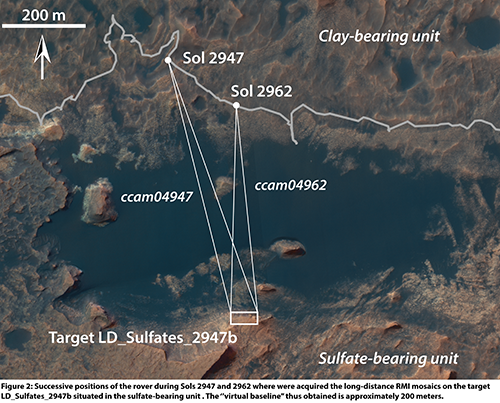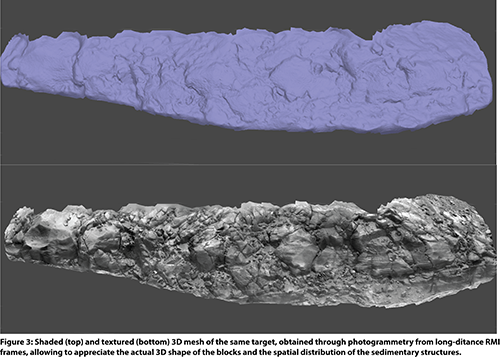- 1CNRS, UMR 6112 CNRS Laboratoire de Planétologie et Géodynamique, Université de Nantes, France (gwenael.caravaca@univ-nantes.fr)
- 2Institut de Recherche en Astrophysique et Planétologie, Université Paul Sabatier, Toulouse, France
- 3Laboratoire de Géologie de Lyon - Terre Planète Environnement, Université Claude Bernard, Lyon, France
- 4Los Alamos National Laboratory, Los Alamos, New Mexico, USA
Gale crater on Mars records a large section of sedimentary rocks, mainly represented by the 5-km-thick sequence of Mount Sharp (Aeolis Mons). The lower part of this sequence has been explored by the Curiosity rover of the Mars Science Laboratory (MSL) mission, revealing lacustrine to fluvial depositional sequences [e.g., 1] bearing clay minerals [2]. Orbital observations highlighted the presence of clay minerals at the base of Mt Sharp but also hint at a major wet to dry environmental change with clay-bearing rocks giving way to several hundred of meters of sulfate-bearing strata [3, 4]. Orbital data coupled with rover-based observations revealed that the sulfate-bearing unit record coincides with a major change of depositional environment followed by alternation of wetter and drier conditions rather than a monotonous aridification during the Hesperian epoch [5].
Before Curiosity reached this part of Gale crater, those observations were supported using long-distance imaging capabilities of the Remote Micro-Imager (RMI) sub-system of the ChemCam instrument [6]. With a focal length of 700 mm, the RMI telescope complements the color Mastcam imagers with higher spatial resolution views of sedimentary structures and textures of rocks outcropping several hundred meters up to a few kilometers away from the rover (a ~60 km-record observation having recently been achieved, [7]). This capacity is therefore used by the MSL team both to plan future guidance of the rover and to observe geologic features from a distance. These long-distance observations pointed at the sulfate-bearing unit reveal the presence of sub-metric-scale cross-stratifications and deflation surfaces as well as diagenetic features (e.g., “satin spar”; Fig. 1). While their size allows for long-range remote observation (i.e., several hundred meters away using imagers onboard the rover, Mastcam and RMI), the resulting images lacks depth due to the distance. Yet, such 3D information can be critical in characterizing and understanding the sedimentary processes behind the setting of these structures.

To improve our observations, we are conducting an imaging experiment to reconstruct the 3D shape of the sulfate-bearing unit outcrops with Structure-from-Motion photogrammetry using ChemCam’s RMI frames. This method is usually performed on close-range geologic features observed with other imagers onboard the rover (MAHLI, Mastcam, Navcam, [8]), but such an approach had never been applied to long-distance RMI frames. Here, we apply photogrammetric treatment to specific sets of repeated long-distance observations on the sulfate-bearing unit. To cope with the high distance of the target, we use a several-hundred meters “virtual baseline” represented by successive positions of the rover along its traverse. Figure 1 shows one of the two long-distance (1x12) RMI mosaics (ccam04947, taken on Sol 2947, cf. Fig. 2) which served as input in the stereoscopic test. This mosaic illustrates an outcrop of the sulfate-bearing unit situated ~650 meters away from the rover at that time (Fig. 2). A second similar mosaic pointed at the same target was taken on Sol 2962 (2x16 RMI mosaic, ccam04962) after the rover drove about 200 meters southeastwards (Fig. 2).

By combining the individual frames of these two mosaics in the photogrammetric chain, we were able to reconstruct the shape of the outcrop. The resulting 3D model presented in Figure 3 reveals the actual 3D shape of the imaged outcrop situated several hundred meters away from the rover, as well as displaying with improved accuracy the spatial distribution of the sedimentary and/or diagenetic structures. The use of this technique to produce long-distance 3D models will have critical implication in helping to assess and to characterize the depositional conditions related to the sulfate-bearing unit, a key objective of the Curiosity rover. The use of these models could also serve to help planning the upcoming exploration of this interval by designating high-interest targets. We also look forward to applying this method to long-distance color images obtained with the more advanced color RMI subsystem of the SuperCam instrument onboard the Perseverance rover currently operating in Jezero crater [9, 10].

References:
[1] Caravaca et al., 2021 LSPC, abstract #1455; [2] Thorpe M. T. et al., 2021, LPSC, Abstract #1519; [3] Miliken et al., 2010, Geophys. Res. Lett. 37, L04201; [4] Fraeman A. A. et al., 2016, J. Geophys. Res. Planets 121, 1713–1736; [5] Rapin et al., 2021, Geology 49; [6] Le Mouélic et al., 2015, Icarus 249, 93-107; [7] Le Mouélic et al., 2021, LPSC Abstract #1408; [8] Caravaca et al., 2020, Planet. Space Science 182, 104808; [9] Gasnault et al., 2021, LPSC Abstract #2248; [10] Gasnault et al., 2021, EGU Abstract #EGU21-16461.
How to cite: Caravaca, G., Le Mouélic, S., Rapin, W., Dromart, G., Fau, A., Mangold, N., Le Deit, L., Gasnault, O., Wiens, R. C., and Lanza, N. L.: Reconstructing the 3D shape of sulfate unit outcrops (Gale crater, Mars) using ChemCam’s Remote Micro Imager onboard the Curiosity rover., Europlanet Science Congress 2021, online, 13–24 Sep 2021, EPSC2021-164, https://doi.org/10.5194/epsc2021-164, 2021.

